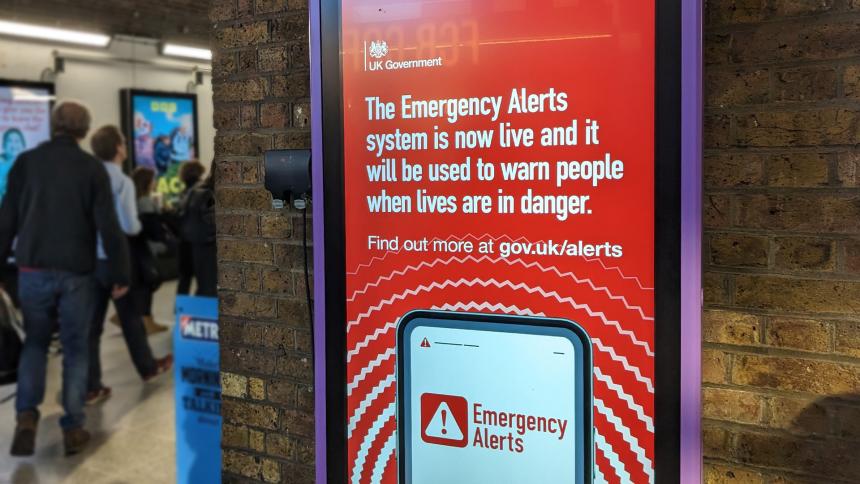
The UK Emergency Alert system: What is it and what time is the test?
The UK government is implementing ‘Emergency Alerts’ to be used in times of life-threatening peril. So, what exactly is this new system, when will it be tested, and what other similar alerts have already been used with impressive effect?
The UK Emergency Alerts system
The first nationwide test of the government's new Emergency Alert System took place on Sunday, 23rd April at 3pm. Across the country, mobile phones and tablets - though not all - vibrated and made a siren-like sound, displaying an alert message to simulate what would happen in the event of a life-threatening disaster.
The system has previously been tested on a local level but this was the first time the whole nation was sent the alert. While it only lasted 10 seconds and required no action by the public, it is an important milestone in how the UK prepares for fires, severe flooding and other dangerous situations.
In the words of Oliver Dowden MP: ‘The UK's Emergency Alert System 'will revolutionise our ability to warn and inform people who are in immediate danger and help us keep people safe. As we’ve seen in the US and elsewhere, the buzz of a phone can save a life.’
However, the government urged people at risk of domestic abuse who may have a hidden mobile phone to take action before the test. Victims often conceal a second phone from their abuser which they could use to help them escape their situation. Domestic violence charity Refuge was concerned that the test could alert abusers to the location of these hidden devices.
After consulting with Refuge, the government has clarified that the alarm wouldn't sound if a phone is turned off or on airplane mode, but it will still ring if a phone is just on silent mode.
There is also information on the Refuge website about how to completely opt out of the Emergency Alerts service.
The US alerts system
Oliver Dowden was alluding to the United States’ two-pronged network used to notify people of major, dangerous events. The Emergency Alert System (EAS) delivers warnings via TV and radio broadcasters, while its sister Wireless Emergency Alerts (WEA) network sends out warnings to mobile devices.
Although these networks allow for US-wide alerts, they’re typically deployed in specific regions to warn of extreme weather events and other dangerous high-risk events. Over the years, however, one issue with the EAS/WEA, and emergency alert systems in general, has been revealed: the very real potential for false alarms.
On 1st February 2005, the EAS sent out an order to parts of Connecticut, calling for an immediate evacuation of the entire state. The startling message was the result of simple operator error, but luckily the notion of a state-wide evacuation was so outlandish that the vast majority of people didn’t take it seriously. It was later reported that the response of most onlookers was to simply ‘change the channel’ and continue watching television.
People reacted far less calmly to another false alarm which took place in the state of Hawaii on 13th January 2018. It was a time of heightened anxiety over the potential threat posed by North Korea, with the dictatorship having carried out a major nuclear test the year before. Hawaii’s relative proximity to North Korea was such a concern that in December 2017 the state had carried out a nuclear air raid siren test for the first time since the Cold War.
So, when Hawaiians received EAS and WEA warnings on the same day, they had good reason to take them seriously. The WEA text alert was an all-caps harbinger of doom, saying: ‘BALLISTIC MISSILE THREAT INBOUND TO HAWAII. SEEK IMMEDIATE SHELTER. THIS IS NOT A DRILL.’ The EAS warning, which popped up on TV screens and radio broadcasts, echoed the fearful message.
There were reports of people stopping what they were doing and seeking shelter, cars speeding up on Hawaii’s highways, and places of work being formally evacuated. Of course, it all turned out to be a gigantic mistake, with miscommunications at the Hawaii Emergency Management Agency leading to a shift worker mistaking a test drill for a genuine attack warning. Amazingly, it later transpired the worker in question ‘had a history of confusing drill and real world events’.
AMBER alerts
As well as providing warnings of large-scale emergencies, the US systems also deploy AMBER alerts which inform the public when a child is thought to have been abducted. The name stands for ‘America’s Missing: Broadcast Emergency Response’, but also commemorates Amber Hagerman, a nine-year-old Texas girl who was snatched from her bicycle and murdered in 1996.
An ordinary Texas woman named Diane Simone was so moved by the story of Amber’s appalling murder (which remains unsolved to this day) that she called a local radio station and suggested there should be a formal alert system for missing kids. This planted the seed that grew into the AMBER alert system, which distributes descriptions of missing children and their suspected abductors via TV/radio broadcasts, text messages and roadside electronic billboards.
AMBER alerts have proven remarkably effective. As of early 2023, well over 1,100 children in the US have been successfully found thanks to members of the public identifying culprits using AMBER alerts. Here in the UK, there’s an equivalent system known as Child Rescue Alert which can be triggered by police forces across the country.
Coded alerts
Some alert systems are designed to be covert, so workers and officials can deal with an issue without the public becoming alarmed.
On the London Underground, for example, cleaning codes are used in tannoy announcements, with numbers indicating what kind of mess needs to be dealt with. The numbers differ between stations, but a ‘code three’ might refer to vomit, a ‘code five’ might signify blood, and so on.
There’s another, more strikingly cryptic code that’s widely used. This is the phrase ‘Inspector Sands’, often heard in announcements like: ‘Would Inspector Sands please report to the operations room immediately.’
This may be used to notify staff of a fire alarm, bomb scare, or other important issues which might cause panic and may require evacuation of the area if it isn’t dealt with. Thought to be a reference to sand-filled fire buckets, the phrase is familiar to many commuters across the UK. However, it’s used far beyond transportation hubs and can be clearly heard in footage of the aftermath of the 2017 Manchester Arena terror attack.








